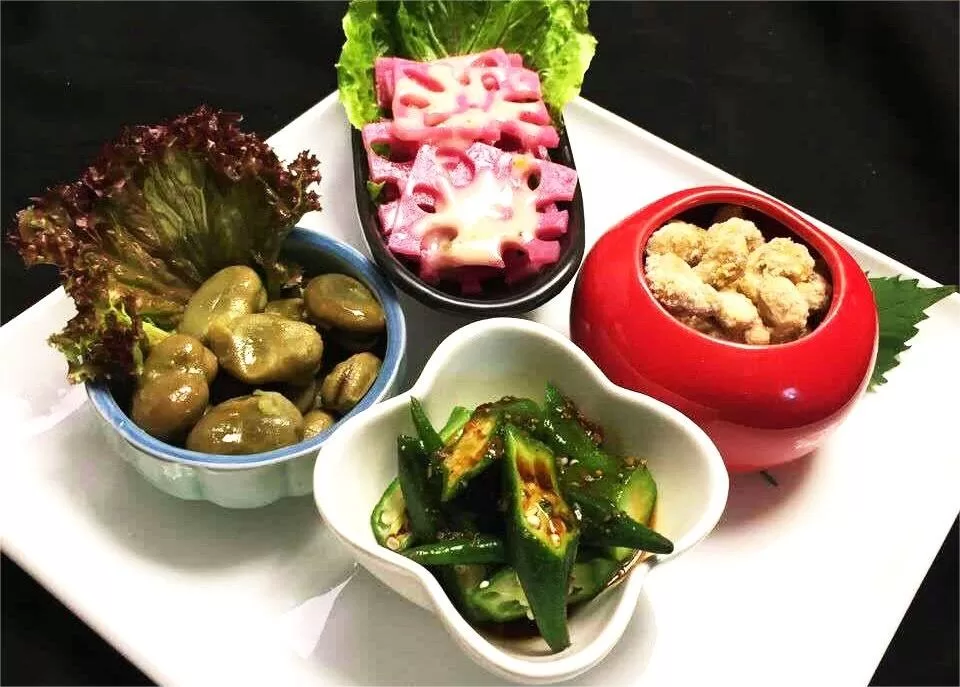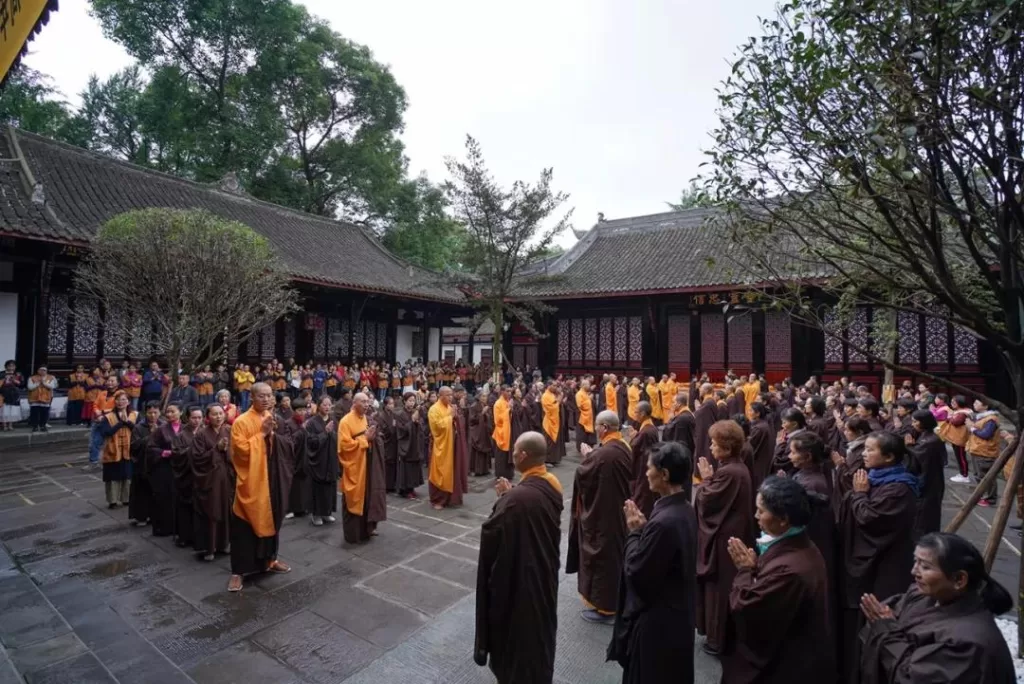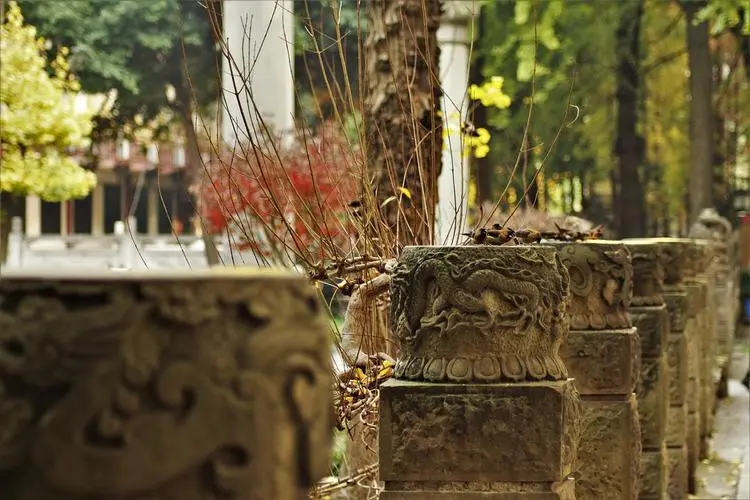Wenshu Yuan Monastery (文殊院, Wenshu Temple), also known as “Konglin Hall (空林堂),” is a prominent Buddhist temple located in the northern part of Chengdu, covering an expansive area of over 200,000 square meters. Its origins trace back to the Sui Dynasty during the years of Da Ye (605-617 AD). However, it underwent significant reconstruction and fundraising in the 36th year of the Kangxi reign (1697) and changed its name into Wenshu Yuan.
The monastery houses an impressive collection of more than 300 Buddha statues, crafted from various materials such as steel, silk, wood carvings, stone carvings, and clay sculptures. Among these treasures is a particularly precious Burmese jade Buddha, originating from Myanmar.
Wenshu Yuan stands out as one of the most well-preserved Buddhist temples within Chengdu. Its architectural style reflects the traditional construction of the Sichuan plains, featuring predominantly wooden structures facing north to south. The layout includes six major halls, which are complemented by structures like the bell tower, dining hall, and corridors on the east and west sides. The monastery also boasts a tea house and a distinctive vegetarian restaurant called “Xiangzhaitang,” making it a popular recreational destination for locals.
Beyond its architectural and culinary appeal, Wenshu Yuan is a repository of valuable artworks, including numerous paintings and calligraphies dating back to the Ming and Qing dynasties. Notable among these is the “Konglin” plaque bestowed by Emperor Kangxi in 1702 and a scroll of “Haiyue” by the renowned calligrapher Mi Fu, both significant treasures. Additionally, the monastery preserves Buddhist artifacts such as the skull relic of Xuanzang from the Tang Dynasty, palm-leaf manuscripts from India, and a gilded sutra from the Tang Dynasty in Japan, adding cultural and historical depth to this sacred site.
Table of Contents
- Basic Information
- Location and Transportation
- Origin of the Name
- Highlights of Wenshu Monastery
- Vlog about Wenshu Monastery
- Useful Tips from Genuine Reviews
- Other Temples in Chengdu
Basic Information
| Estimated Length of Tour | About 2 hours |
| Ticket Price | Free |
| Opening Hours | 8.00 – 17.00 |
| Telephone Number | 0086-028-86930623 0086-028-86662375 |
Location and Transportation
Wenshu Yuan Monastery is located in the northern part of Chengdu’s city center, in the Qingyang District of Sichuan Province, China. Its address is No. 66, Wenshu Yuan Street, Qingyang District, Chengdu City. The temple is easily accessible by public transportation, including buses and the Chengdu Metro (How to get from CTU to Wenshu Yuan Monastery in chengdu by subway).
Metro: The nearest metro station to Wenshu Yuan Monastery is Wenshuyuan (文殊院) on line 1. After getting out of the station from Exit K, you still need to walk about 100 meters to the north to reach the temple.
Bus: Take bus 16, 42, 55, or 75, get off at Wenshuyuan (文殊院), and you will be standing right to the entrance of the temple.
Origin of the Name
Wenshu Yuan Monastery, initially established during the Sui Dynasty, underwent a rich history spanning the Tang, Five Dynasties, Song, Yuan, and Ming periods. Originally known as Xinxiang Yuan and Xinxiang Temple, it wasn’t until 1697 that the monastery adopted its present name, Wenshu Yuan.
Around the year 1681, the venerable monk Cidu, also known as Cidu Chanshi, arrived at the abandoned site of Xinxiang Yuan. Driven by a vow to restore the monastery and revive the legacy of Master Xinxiang Jinglao, who had once presided over the site, Cidu Chanshi took up residence between two ancient Chinese juniper trees. Living a simple life, he devoted himself to Zen meditation.
Cidu Chanshi’s exceptional spiritual practice soon gained attention when he manifested auspicious flames during meditation. The local populace, captivated by this seemingly miraculous phenomenon, began to believe that Cidu Chanshi was the earthly incarnation of Manjushri Bodhisattva, the Bodhisattva of Wisdom. Fueled by the admiration of the people, and with the support of local authorities and literati, the monastery underwent a name change, becoming Wenshu Yuan, to honor the perceived divine connection with Manjushri Bodhisattva, also known as Wenshu Pusa in Chinese.
Highlights of Wenshu Monastery
Layout of Wenshu Monastery

Wenshu Yuan Monastery is a testament to architectural elegance and spiritual significance, featuring a layout that embodies profound symbolism and historical richness. The monastery’s design revolves around a central axis, stretching over 200 meters, adorned with six major halls and complemented by ornate gateways and intricate pavilions. The arrangement of these halls is meticulous, reflecting a blend of grandeur and tranquility.
The entrance to the monastery begins with the Tianwang Hall, also known as the Mountain Gate, constructed by Cidu Chanshi and later modified by Master Benyuan. This hall reveres Maitreya Bodhisattva and the Four Heavenly Kings. Following this is the Three Heroes Hall, alternatively known as the Guanyin Hall, erected in the 36th year of the Kangxi reign (1697). Here, Guanyin, Manjushri, and Samantabhadra are venerated, with additional altars dedicated to Wen Chang Emperor and Guan Yu.

The majestic centerpiece is the Mahavira Hall, originally built by Cidu Chanshi and reconstructed by Master Zhangbo. Standing at 10.56 meters tall, this hall enshrines a towering bronze statue of Sakyamuni Buddha, flanked by bronze figures of Kashyapa and Ananda, all cast in the ninth year of the Daoguang era (1829).
Adjacent to the Mahavira Hall is the Hall of Preaching, also known as the Medicine Master Hall, believed to be situated on the ancient site of the Xinxiang Temple. Within this hall stands a brick altar adorned with a calligraphy inscription of “Konglin” by Emperor Kangxi. Beneath a precious canopy lies a statue of the Medicine Buddha, flanked by twelve statues of the Medicine Generals.

The Scripture Hall, established by Cidu Chanshi and later rebuilt by Master Benyuan in the fourth year of the Daoguang era (1824), comprises two floors and serves as the repository for scriptures and significant artifacts of the monastery, towering at 15.84 meters high.
Lastly, positioned at the end of the central axis within Wenshu Yuan is the Wenshu Pavilion, spanning 1000 square meters and divided into the “Konglin Lecture Hall” on the first level, the Konglin Buddhist Library on the second level, and the Wannian Hall on the third level, collectively forming an essential part of the monastery’s spiritual and educational infrastructure.
Vegetarian Cuisine

The vegetarian cuisine at Wenshu Yuan Monastery is famous for its delicious flavors and healthy ingredients. The monastery has a long history of promoting vegetarianism, which is considered an important part of Buddhist practice. The restaurant serves a wide variety of dishes, including local Sichuan specialties like Mapo Tofu and Kung Pao Chicken, but made with plant-based substitutes. The food is prepared using fresh, locally-sourced ingredients, and is free from meat, fish, and poultry. Visitors can enjoy a wholesome and nutritious meal while experiencing a unique aspect of Buddhist culture.
Buddhist Ceremonies and Rituals

Wenshu Yuan Monastery offers a range of Buddhist ceremonies and rituals that visitors can participate in to gain insight into Buddhist culture and spirituality. Meditation sessions are held regularly, allowing visitors to practice mindfulness and stillness. Sutra chanting ceremonies are also held, where visitors can chant Buddhist texts and mantras. The monastery also hosts Buddhist festivals throughout the year, including the Lantern Festival and the Buddha’s Birthday celebration. Participating in these ceremonies and rituals can offer a unique and enriching experience for visitors to Wenshu Yuan Monastery.
Buddhist Relics

Wenshu Yuan Monastery treasures two significant Buddhist relics, enriching its spiritual ambiance. The first relic is a particle of the Buddha’s bone ash, enshrined in the Scripture Hall. In the 1920s, Monk Fojin, a virtuous monk from Youyang, Chongqing, acquired this relic during a pilgrimage to Bodh Gaya, India. Monk Fojin, entrusted with managing the sacred fire at Bodh Gaya, requested Venerable Nenghai to bring the Buddha’s bone ash back to Wenshu Yuan for veneration.
Adjacent to the Scripture Hall, on the left side, the monastery houses another revered relic – the skull relic of Xuanzang. Discovered in the 1940s at the Bao’en Temple in Nanjing, this relic holds particular significance as Xuanzang, a prominent Chinese Buddhist monk, received ordination in Chengdu and lived in the city for five years. The pilgrimage to Nanjing brought back a portion of Xuanzang’s skull relic, reinforcing the spiritual heritage of Wenshu Yuan.
Vlog about Wenshu Monastery
Useful Tips from Genuine Reviews
Caution with Street Vendors: Avoid buying items like prayer beads and red strings from street vendors around Wenshu Yuan Monastery, as they may overcharge. Be cautious with self-proclaimed “masters” offering fortune-telling services; some may charge exorbitant fees. Some shops outside Wenshu Monastery may sell fake items, so it’s advisable to bargain and carefully inspect purchases.
Dress Code and Etiquette: When visiting the monastery, dress neatly and avoid wearing unusual or flashy clothing. Refrain from taking photos directly in front of the Buddha statues. Upon entering, it is said to step in with the right foot without stepping on the threshold. The monastery has rules against the use of red cloth, red candles, and bringing pets. Additionally, the consumption of meat and alcohol is prohibited.
Free Incense Distribution: Inside the monastery, there is a place where visitors can receive three free sticks of incense each.
Food Options: There are various food options outside Wenshu Yuan Monastery. The recommended choice is the combination of copying scriptures, tea drinking, and vegetarian meals. Wenshu Yuan’s own vegetarian restaurant, Xiang Yuan, is highlighted for its cost-effectiveness, with a vegetarian self-service hotpot priced at 50 yuan per person and mushroom rice at 18 yuan per bowl.
Photography Recommendations: For photography, it is suggested to visit in the morning (9 am – 11 am) or late afternoon (5 pm – 6:30 pm). During these times, the sunlight is not too harsh, there are fewer people, and there is usually less waiting time for taking pictures in front of the red walls.




